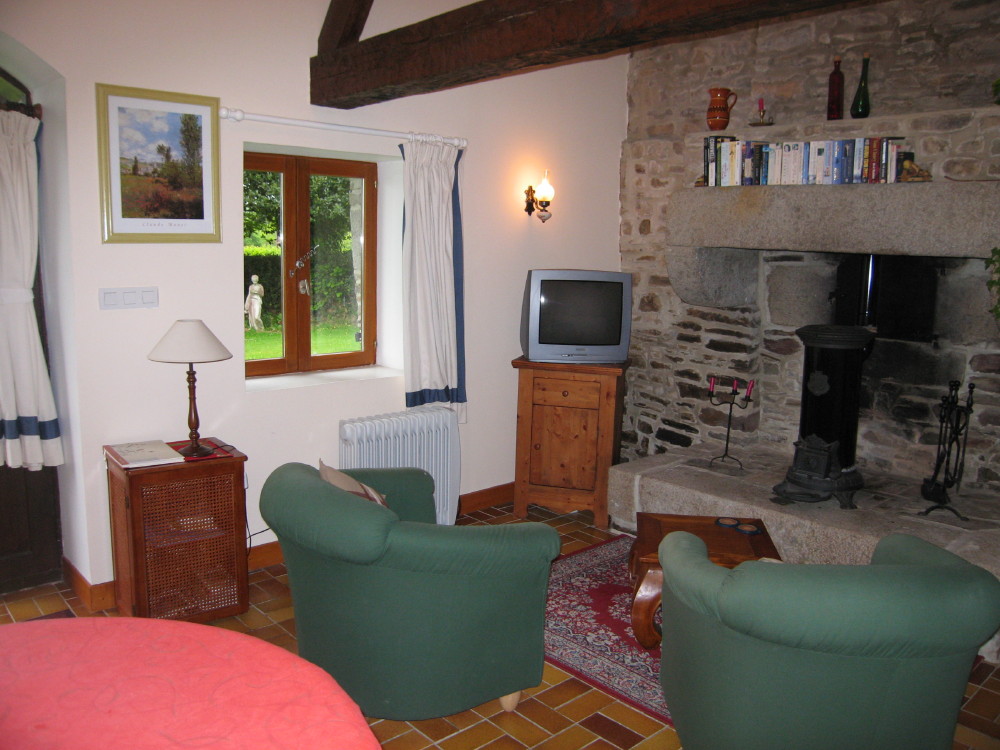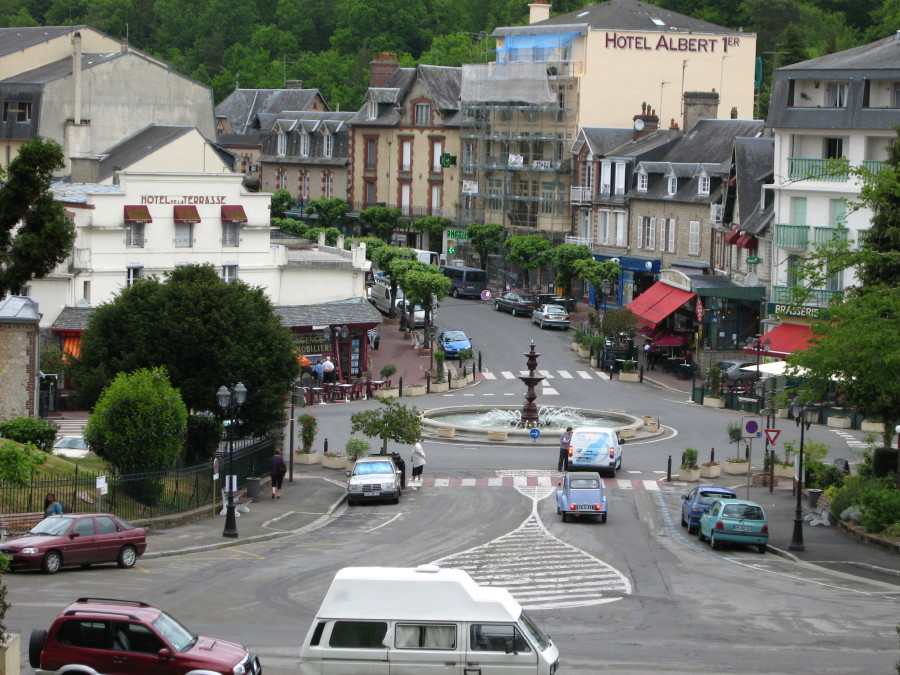
Normandie, France
May 24-29, 2010
La Sittelle
This was the name of the stone cottage we stayed in near Tinchebray in Normandie. It had two rooms downstairs and a bathroom above the bedroom, with a rather steep stairway.

Here's the living room. The fireplace is in the middle below the chimney. We didn't need to use the stove. The cottage was comfortable the whole time we were there. What looks like a lady out in the yard is actually a small stone statue.

|
|
|
|
|
|
Here are the kitchen part of the front room, the bedroom, the stairs and the bathroom above. We were very comfortable here.
________________________________________________________________________________
We went out each day to explore places not too far away. Most of our drives were less than an hour and sometimes less than 1/2 an hour. We used a GPS that we brought from home with European maps. We wondered at times why "she" picked the roads she did. It was set on "fastest route" but she would pick the smallest little roads. We realized that the speed limit on those roads was 90 kph, which was much faster than it was possible to drive on them. Some of them had hairpin turns, and occasionally went down to one lane, but apparently that doesn't figure in the algorithm the GPS uses to calculate time of travel.
Mortain
This was the first little town we visited. It was a typical small French town. People were shopping here as we were here in the morning. The tourist office gave us a helpful guide with a walking tour that took us a little ways down a hill to see a waterfall.
I needed some stamps, so looked around here for the Post office, but it was actually about a block away. I bought two stamps and stuck them in an envelope that I had previously addressed. I planned to put a post card in it and send it to the young girl I mentor, but I hadn't written the post card yet.
The smaller of the two waterfalls in this town.
We walked back up to the town along this road.
We passed a farm and some donkeys on the way.
Domfront
Then we drove to Domfront about 1/2 an hour away.
Domfront is a town with a medieval character, some restaurants, churches and a ruined castle. The 1920's church at the end of the road had a unique architecture. It was one of the first churches to be built of a new building material--concrete. And because the site was quite small it was built in a square shape typical of Byzantine churches. They are trying to raise money to renovate and restore it.
One of the restaurants in Domfront.
Part of the ruined castle. William the Conqueror had been here. Historical tidbit: (This may or may not interest you. I thought it was fascinating.) Aliénor d'Angleterre or de Castille (Eleanor of England or Castille) daughter of Henry II of England and Eleanor of Aquitaine was born in Domfront in 1161. She was also the grandmother of Saint Louis (Louis IX of France).
The old drawbridge is now a permanent bridge, leading back into the town.
Looking over the castle wall to another part of the town and the Romanesque, 12th century church, Notre Dame sur l'Eau.
Le Bocage de Normandie

It has taken me a while to learn what is meant by the Norman Bocage. I was struck by the rolling green hills, and small fields marked off by green hedgerows, but didn't realize that that is what the Norman Bocage is. We saw it everywhere from the car, but I don't have many pictures of the countryside. If you look you'll see it in the background of some of these photos.
Bagnoles de l'Orne
Next we stopped at Bagnoles de l'orne, a town famous for hot, therapeutic baths, a casino and a lovely lake.

We stopped for a coffee here in the afternoon and I wrote my postcard.
Another church from the 20th Century, this time in Art Deco style.

The lake and Casino. There was a post office near here, so I walked over there while Jim found an ATM across the street. I had a little trouble finding the slot to drop my letter into, but did find it in the wall finally, mailed the post card and felt good about getting that done on our first day. I thought I'd save myself a step by addressing two envelopes at home and bringing them with me, so that I just needed to slip a postcard inside the envelope, buy a stamp and mail it.
Vire
We went into Vire that evening for dinner. Vire was the closest town to the cottage that had a restaurant, I think.
This is what remains of the 12th century castle keep, now in the middle of a busy square. Vaux de Vire is the name of the valley of the confluence of the rivers Vire and Varenne. Vaux de Vire also referred to the collection of songs of a textile worker Olivier Basselin, who lived here in the 15th century. The word vaudeville comes from Vaux de Vire(1). I'll bet you didn't know that.
Back at La Sittelle that evening I was thinking about the things we'd done that day and remembered that I had a second envelope and stamp for another postcard. Then I couldn't remember what I'd done with the stamp. Suddenly I had the horrible realization that I had not taken the 2 stamps out of the envelope, but sealed it up with both of them inside and dropped it in the box with no stamp on the outside. I was so mad at myself then. At least I still had the second envelope, so I could try again with another postcard, but would also have to buy another stamp.
There's more to this story, but you have to go to the next page for the rest.
More of Normandy, including Mont-Saint-Michel
(1) Michelin Guide: Normandy, 1980